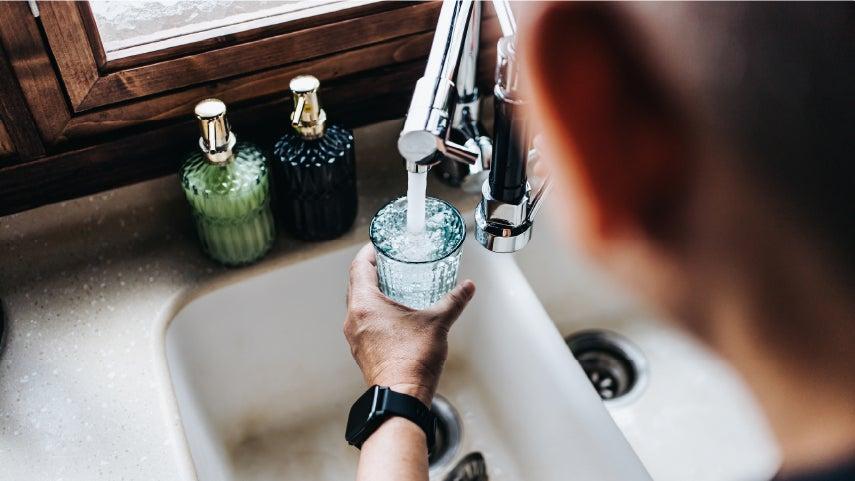
Related Topics
From groceries and gas to rent, living costs are soaring—and that includes home energy bills. According to data analyzed and reported by the National Energy Assistance Directors Association, electricity prices currently outpace inflation by nearly double.1 And the strain on household budgets is significant: forcing people to make impossible choices between heat and A/C or other basic necessities.
In fact, roughly 1 out of 6 U.S. households (21.5 million) are behind on their energy bills already.1 And not having help when you're behind on paying the bill is both stressful—and harmful.
That's because living in “heat or eat” mode—choosing between basic needs and properly heating and cooling your home—puts your health and safety at risk. It’s also dangerous to live in a home that's too cold or too warm, especially when you’re an older adult or someone with a disability. If you need help paying utility bills, relief is available through the Low-Income Home Energy Assistance Program (LIHEAP).
What is the Low-Income Home Energy Assistance Program (LIHEAP)?
Created in 1981, LIHEAP is a federally sponsored, need-based safety net program that provides financial support to 6.7 million households.2 LIHEAP helps people stay warm throughout the chilly winter months and cool during the summer, offering assistance for:
- Home energy bills
- Improvements to homes and apartments to make them more energy-efficient (also known as weatherization)
- Minor, energy-related home repairs
- Emergency help with utility bills (in case of a utility shutoff, for example)
The LIHEAP option serves as a lifeline for people like Ms. B., age 63, who unexpectedly lost her job during the pandemic. She turned to one of our Benefits Enrollment Centers (BECs), facing difficult choices between paying for medicine, bills, and food. We helped Ms. B. apply for LIHEAP and other programs, and she was approved for $350 in aid.
I was desperate, and these benefits were a big help during trying times," Ms. B said.
Where does LIHEAP funding come from?
LIHEAP funds are distributed locally at the state, territory, or tribe level in the form of monetary grants. When annual LIHEAP funding runs out, no more grants can be awarded until the government releases additional funds. Despite significant cuts to federal staff who oversee the program—and a proposal to fully eliminate LIHEAP funding for fiscal year 2026—the National Energy Assistance Directors Association (NEADA) believes that strongn bipartisan Congressional support will prevail.3
In a letter to the U.S. Department of Health and Human Services Secretary Robert F. Kennedy, Jr., NEADA Executive Director Mark Wolfe urged the upholding of precedent. Noting that previous Administrations, including President Trump’s first, have consistently funded LIHEAP at 90% of the previous year, he wrote:
“Both the House and Senate Appropriations Committees have signaled continued funding for LIHEAP above FY2025 levels … these funds are most effective when they are deployed early in the heating season, preventing families from falling behind on their bills instead of forcing utilities to initiate shutoff procedures that are expensive to both the utility and the customer.
Who is eligible for LIHEAP assistance?
Homeowners, renters, and those who live in subsidized housing may be able to apply for help with utility bills through LIHEAP. To qualify, you must have a financial need and meet specific income limits. Individual states set their own LIHEAP income eligibility limits within certain guidelines established by law. Current LIHEAP income guidelines require an income that is no more than 150% of the federal poverty guideline or 60% of a state's median income.
Here are a few most recent state-specific examples:
- A two-person household in Texas with an annual household income of $38,541 or less might qualify for LIHEAP.
- A two-person household in Ohio with an annual household income of $37,012.50 or less might qualify for LIHEAP.
- A two-person household in Florida with an annual household income of $40,000 or less might qualify for LIHEAP.
- A two-person household in California with a monthly household income of $4,145.41 or less might qualify for LIHEAP.
You may be automatically eligible for LIHEAP if you or another person in your household is enrolled in other benefit programs, such as the Supplemental Nutrition Assistance Program (SNAP), Supplemental Security Income (SSI), and Temporary Assistance for Needy Families (TANF). Be sure to check with your state for the most accurate, up-to-date LIHEAP income guidelines.
How does LIHEAP work?
LIHEAP provides partial, short-term help with utility bills. It's not designed to cover all of your energy costs for the year, or even for that season. For instance, Ms. Praylow, age 69, was finding it hard to pay her bills and keep food on her table. After learning she qualified for help with utility bills, an advisor at one of our BECs walked her through the LIHEAP application process. Ms. Praylow was awarded $200 in emergency funds and received a credit on her electric and gas invoice.
LIHEAP funds are generally meant to cover heating and cooling costs only. They cannot be used to pay your water or sewer bill, unless the water is used for air conditioning (in an evaporative cooler, for example). There is a separate benefit program available for water assistance called the Low-Income Household Water Assistance Program (LIHWAP).
Additonally, most states only allow you to get LIHEAP assistance with your primary energy source (meaning electric or gas, but usually not both).
In some states, you can also use part of your LIHEAP grant to make energy-related repairs and improvements to your home. This can help you save on energy costs in the future. Examples of energy-efficient upgrades include:
- Fixing or replacing a broken or inefficient air conditioner or furnace
- Repairing drafty windows and doors
- Insulating your home
How much can you get in LIHEAP assistance?
There is no standard benefit amount. Rather, the amount of LIHEAP assistance you can get depends on factors such as:
- Where you live
- Your income
- The size of your household
- Your specific energy needs
Certain states receive more LIHEAP funding than others and can provide larger grants to qualifying households.
How do I apply for LIHEAP?
Each state, territory, and tribe has its own LIHEAP guidelines, application form, and application deadlines. Some states require applications to be mailed in, while others allow you to apply for LIHEAP online. Your best bet is to contact your local LIHEAP office for details. You can also call the toll-free LIHEAP phone number at 1-866-674-6327.
Do you qualify for LIHEAP? Find out today at BenefitsCheckUp
Don’t spend another winter or summer worrying about utility bills. Visit BenefitsCheckUp, enter your ZIP code, and click on “Housing & Utilities” to browse LIHEAP and other state and private programs that could help you lower your energy costs. It takes just a moment to see what kind of aid is might be available in your area.
Sources
1. Mark Wolfe. The Cost of Power: How Soaring Electric Rates Are Deepening Energy Poverty in America. National Energy Assistance Directors Association. August 2025. Found on the internet at https://neada.org/wp-content/uploads/2025/08/costofpower.pdf
2. LIHEAP.org. Understanding the Impact of LIHEAP. Found on the internet at https://www.liheap.org/
3. National Energy Assistance Directors Association. LIHEAP Still Here, But Threats Loom. Found on the internet at https://neada.org/press/liheap-under-threat/




